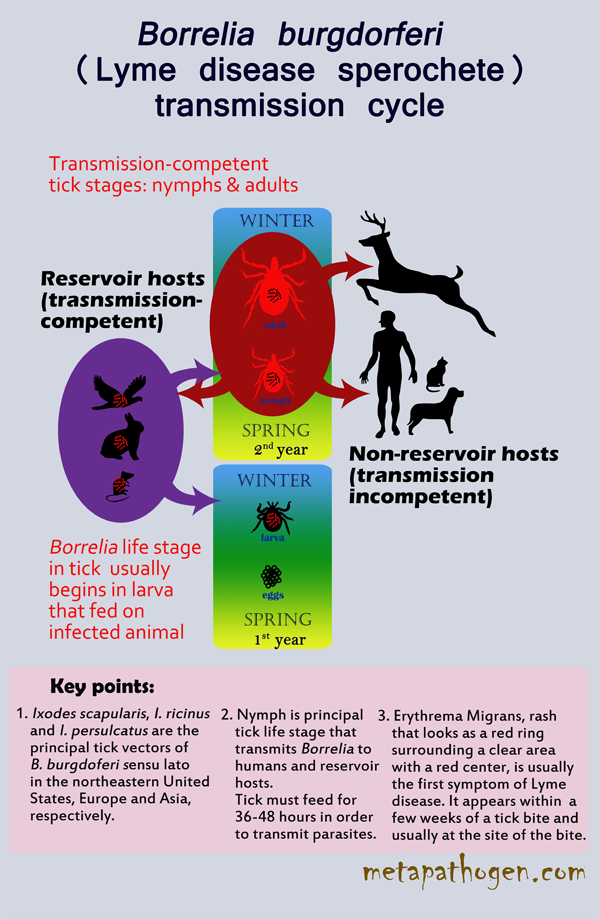Borrelia burgdorferi Lyme disease spirochete
Taxonomy
Taxonomic lineage
cellular organisms - Bacteria - Spirochaetes - Spirochaetes (class) - Spirochaetales - Spirochaetaceae - Borrelia - Borrelia burgdorferi group - Borrelia burgdorferi
Phylum Spirochaetes
Spirochaetes is unique phylum of bacteria: in addition to a typical bacterial plasma membrane surrounded by a cell wall containing peptidoglycan, they have an outer lipid bilayer membrane, also referred to as an outer membrane sheath. The space between the protoplasmic cell cylinder and the outer membrane sheath is called periplasm, or periplasmic space. Flagella of spirochetes are similar to the flagella of rod-shaped bacteria but are located between the protoplasmic cell cylinder and outer membrane sheath and are referred as periplasmic flagella (PF). Each PF is attached to one end of the cell cylinder and extends toward the opposite end. These flagella unable spirochetes to swim faster in a high-viscosity gel-like medium than in low-viscosity media. For most of the bacteria the situation is reverse. The phylum contains the only class Spirochaetes with single order Spirochaetales. The order includes several important human pathogens such as Leptospira (family Leptospiraceae), Borrelia and Treponema (family Spirochaetaceae).
Treponema pallidum, causative agent of syphilis: taxonomy, history, biology at MetaPathogen
Genus Borrelia
Genus Borrelia was named after French bacteriologist Amedée Borrel (1867–1936) in 1907is. These organisms cause tick-borne and louse-borne relapsing fever in humans and animals. For example, B. hermsii, transmitted by Ornithodoros hermsi ticks, causes relapsing fever in the Western United States, and B. recurrentis causes louse-borne relapsing fever worldwide. B. burgdorferi was isolated from patients with arthritis-like symptoms by Willy Burgdorfer and Alan G. Barbour in 1982, is the etiologic agent of Lyme disease.
Borrelia burgdorferi group
Borrelia burgdorferi group and Borrelia burgdorferi sensu lato are synonyms. Three species of B. burgdorferi cause most human disease: B. burgdorferi sensu stricto, B. garinii, and B. afzelii. B. burgdorferi sensu stricto is the only species associated with human disease in the United States, whereas all three species occur in Europe, and B. garinii and B. afzelii occur in Asia. B. garinii and B. afzelii are antigenically distinct from B. burgdorferi sensu stricto, and these differences may account for the variation in disease symptoms in different geographic regions.
General information
Morphology
B. burgdorferi are relatively large bacteria with a diameter of 0.33 μm and a length of 10-20 μm. Wild-type cells at rest have a flat-wave morphology having mostly planar, sinusoidal deformations. A swimming cell usually rotates counterclockwise in cork-screw manner as waves propagate along its length. Attached to each end are 7-11 periplasmic flagella that overlap in the center of the cell. The flagella influence cell shape: with them, the cells are wave-like, and without them, they are rod-shaped. The flagella-produced specific spirochetal motility and together with ability of the bacterium to hijack some host's enzymes such as plasminogen enable it to quickly disseminate throughout the host's body even in poorly vascularized connective tissues without using blood vessels. Another potential advantage to the flagellar arrangement of spirochetes is the shielding of the highly conserved and immunogenic flagella from the host immune system.
Geographic distribution
There is a distinct geographic distribution of Lyme disease in both the United States and Europe. Twelve US states account for 95% of the reported cases of Lyme disease. These states include the mid-Atlantic and coastal northeastern states. The highest incidence of Lyme disease in Europe occurs in central Europe.
Genome
The genome of B. burgdorferi s.s. species consists of a linear chromosome including 910,725 bp and 21 extrachromosomal elements (plasmids) consisting of about 613,000 bp. Nine plasmids are circular and 12 are linear. circular and 12 linear). This abundance of plasmids (40% of total genome) is unusual and unique in bacterial world with Chlamydia coming in a distant second with 7 plasmids. Today, the genome of B. burgdorferi s.s. (B31) is completely sequenced. The linear structure of the chromosome and many of the plasmids is also unusual in the bacterial world. Other bacteria with linear chromosomes are Streptomyces coelicolor and S. avermitilis, Rhodococcus sp. strain RHA1 and Agrobacterium tumefaciens. Most genes encoded on the B. burgdorferi chromosome are commonly found in other bacterial genomes. Majority of genes on the plasmid component of the genome appears to be unique to genus Borrelia.
Survival strategies
In addition to its complex genetic makeup, B. burgdorferi engages in so-called "stealth pathology" to evade the host's immune response. Stealth pathology involves following strategies: (1) suppression of host immune system; (2) mutagenesis (possible occurrence of antibiotic resistant mutants); (3) life stage switching (dormant cysts and actively reproducing and disseminating bacteria); (4) variable antigen production; (5) physical seclusion (colonization of poorly vascularized tissues); (6) secreted factors (enable dissemination by helping bacteria to adhere to cells and pierce the cell walls).
Gene switching depending on host
Surface lipoproteins Osp (outer surface proteins), OspA, OspB, OspC, OspD, OspE and OspF, plays an essential role in the pathogenicity of Lyme borreliosis. The survival of B. burgdorferi in tick and in the organism of mammals is partly attributed to the selective expression of these lipoproteins: the expression of ospA and ospB is immediately activated when the spirochetes penetrate into the vector arthropod whereas during the transmission from the vector to the host-vertebrate, the expression of ospA and ospB is reduced and synthesis of OspC, DbpA and BBK32 is increased.
